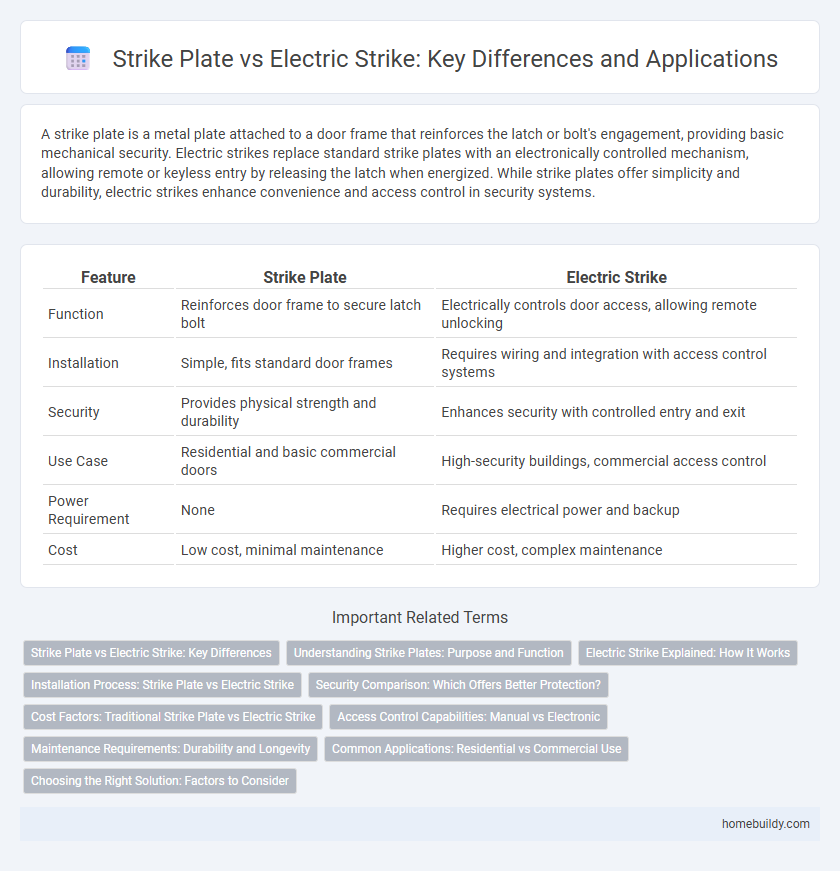A strike plate is a metal plate attached to a door frame that reinforces the latch or bolt's engagement, providing basic mechanical security. Electric strikes replace standard strike plates with an electronically controlled mechanism, allowing remote or keyless entry by releasing the latch when energized. While strike plates offer simplicity and durability, electric strikes enhance convenience and access control in security systems.
Table of Comparison
| Feature | Strike Plate | Electric Strike |
|---|---|---|
| Function | Reinforces door frame to secure latch bolt | Electrically controls door access, allowing remote unlocking |
| Installation | Simple, fits standard door frames | Requires wiring and integration with access control systems |
| Security | Provides physical strength and durability | Enhances security with controlled entry and exit |
| Use Case | Residential and basic commercial doors | High-security buildings, commercial access control |
| Power Requirement | None | Requires electrical power and backup |
| Cost | Low cost, minimal maintenance | Higher cost, complex maintenance |
Strike Plate vs Electric Strike: Key Differences
A strike plate is a metal component installed on a door frame that reinforces the latch or bolt area, providing a secure surface for mechanical locks. In contrast, an electric strike replaces the standard strike plate and works with electronic access control systems to remotely release the door latch. The key difference lies in the strike plate's passive security function versus the electric strike's active control capability for enhanced access management.
Understanding Strike Plates: Purpose and Function
Strike plates are metal components mounted on door frames that reinforce the latch or bolt securing the door, ensuring proper alignment and enhanced security. Unlike electric strikes, which offer remote access control and electronic locking capabilities, standard strike plates serve a purely mechanical function by providing a solid surface for the latch to engage. Their primary purpose is to distribute the force applied during door closure and preventing wear on the frame, thereby maintaining door integrity and security over time.
Electric Strike Explained: How It Works
Electric strike is an access control device installed in the door frame that replaces the standard strike plate, allowing remote or automatic unlocking. It works by releasing the latch bolt electronically when a signal is received from a keycard, intercom, or keypad system, providing secure and convenient entry without manually using a key. Unlike a traditional strike plate, electric strikes enhance security integration and enable controlled access in commercial and residential settings.
Installation Process: Strike Plate vs Electric Strike
The installation process for a strike plate is straightforward, involving simple alignment with the door latch and securing it to the door frame using screws, making it a quick and cost-effective solution for basic door security. In contrast, installing an electric strike requires more complex wiring and integration with access control systems, demanding professional expertise to ensure proper functionality and compliance with security standards. Electric strike installation often involves cutting into the door frame and connecting to power sources, which increases installation time and costs compared to the traditional strike plate method.
Security Comparison: Which Offers Better Protection?
A strike plate is a basic metal plate that reinforces the door frame and provides a secure anchor point for the latch bolt, offering fundamental physical security. An electric strike enhances security by allowing remote release and integration with access control systems, enabling advanced authentication methods and monitoring capabilities. While strike plates provide solid mechanical strength against forced entry, electric strikes offer superior protection through controlled access and real-time security management.
Cost Factors: Traditional Strike Plate vs Electric Strike
Traditional strike plates typically incur lower upfront costs, making them budget-friendly for standard door locking systems. Electric strikes, while more expensive initially, offer enhanced security features and integration with access control systems which can justify higher installation and maintenance expenses over time. Evaluating cost factors involves considering not only the initial purchase price but also long-term operational efficiency and security needs.
Access Control Capabilities: Manual vs Electronic
Strike plates provide basic manual access control by reinforcing door frames and securing latch bolts, ensuring physical security without electronic intervention. Electric strikes enable advanced electronic access control capabilities, such as remote unlocking, integration with keycard systems, biometric scanners, and automated lock management. This electronic functionality enhances security monitoring and user convenience beyond traditional mechanical locking methods.
Maintenance Requirements: Durability and Longevity
Strike plates require minimal maintenance due to their solid metal construction, ensuring high durability and long lifespan under regular use. Electric strikes, while offering enhanced security features, demand more frequent inspections and maintenance to address mechanical and electrical components prone to wear and environmental factors. Choosing between them depends on balancing durability with the complexity and upkeep associated with electric strike systems.
Common Applications: Residential vs Commercial Use
Strike plates are commonly used in residential settings to reinforce door frames and ensure proper latch engagement for standard mechanical locks. Electric strikes are more prevalent in commercial environments where access control systems require remote or automated locking mechanisms integrated with keycards or keypad entry. Both devices enhance security, but electric strikes offer advanced functionality suitable for high-traffic or restricted-access areas.
Choosing the Right Solution: Factors to Consider
Choosing between a strike plate and an electric strike depends on security needs, access control requirements, and installation complexity. Strike plates offer a basic mechanical solution ideal for traditional locks, providing durability and simplicity. Electric strikes enable remote access and integration with electronic security systems, making them suitable for higher security environments with frequent entry control.
Strike plate vs electric strike Infographic

 homebuildy.com
homebuildy.com